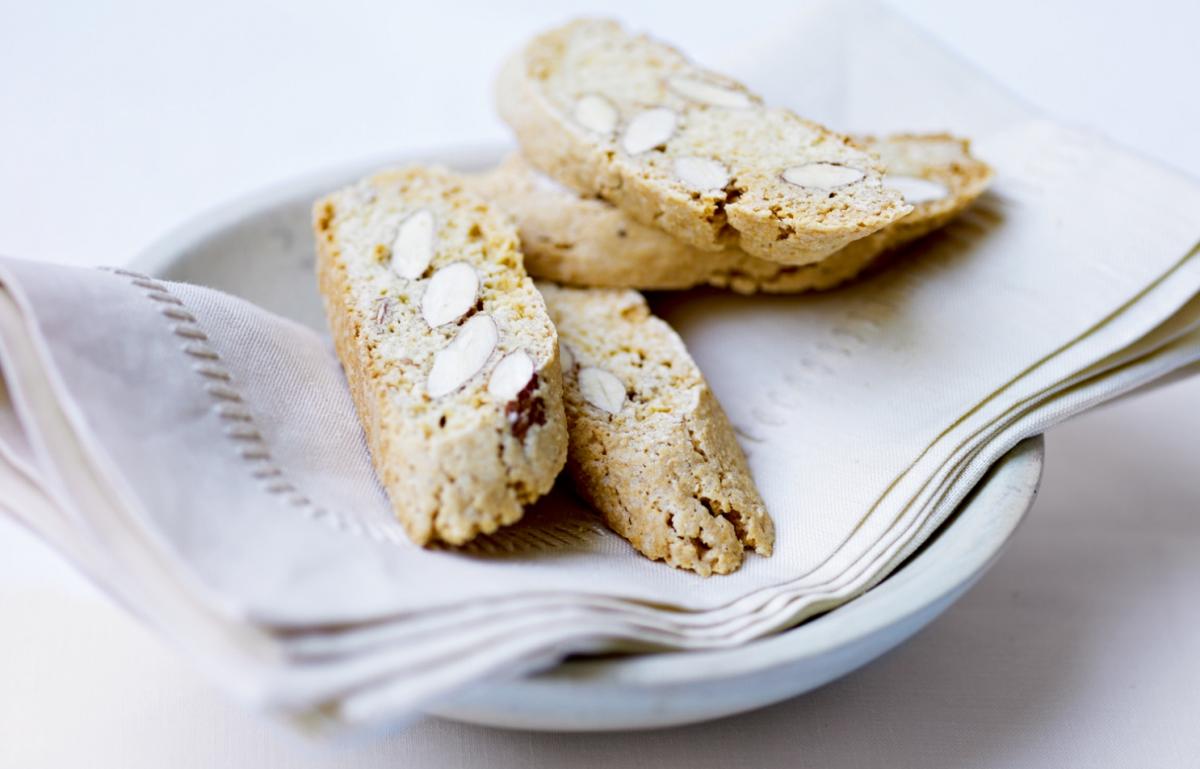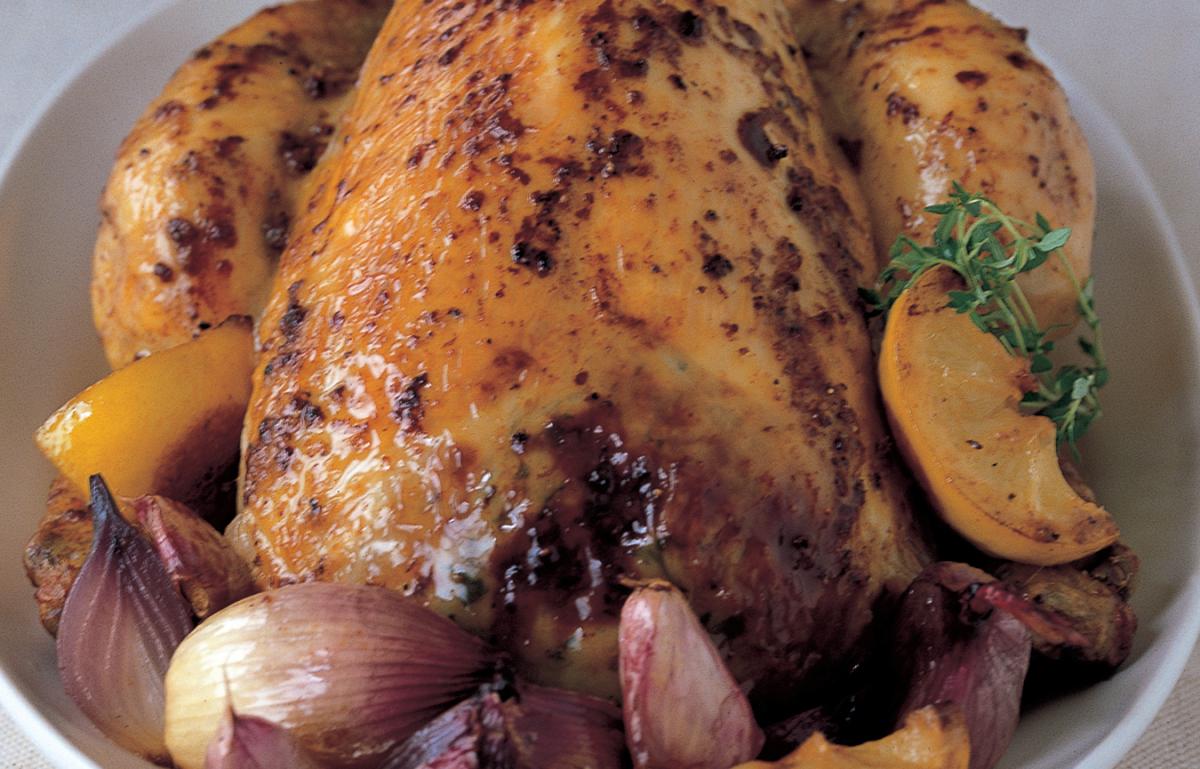

This is a family roast chicken, moist and succulent for Sunday lunch, with lots of crispy bacon, real chicken-flavoured gravy, some very savoury stuffing and a sauce.
All it needs is some vegetables with piles of crunchy roast potatoes, and some family and friends to share the feast.
The Delia Online Cookery School. You can watch how to make the Best Roast Chicken in our video. Just click the recipe image to play.
This recipe is from Delia's Complete How to Cook. Serves 6-8
Apple, Sage and Onion Stuffing:
If you have a food processor, making stuffing is a doddle: all you do is switch the motor on, add the pieces of bread and process to crumbs, then add the parsley, sage, apple and onion quarters and process till everything is finely chopped.
Next trim any sinewy bits from the chicken livers, rinse under cold water, pat them dry, then add them, together with the sausage meat, mace and seasoning. Give a few pulses in the processor until it is all thoroughly blended, remove the stuffing from the processor with a spatula, then place in a polythene bag and store in the fridge until it is required. If you're doing this by hand, just finely chop all the ingredients, combine in a bowl and refrigerate as above.
Traditional Roast Chicken:
Pre-heat the oven to gas mark 5, 375°F (190°C).
First of all the chicken needs to be stuffed, and to do this you begin at the neck end, where you'll find a flap of loose skin: gently loosen this away from the breast and you'll be able to make a triangular pocket. Pack about two-thirds of the stuffing inside, as far as you can go, and make a neat round shape on the outside, then tuck the neck flap under the bird's back and secure it with a small skewer or cocktail stick. Take the remaining stuffing and place it in the body cavity (the fat in the pork will melt and help to keep the bird moist inside). Now place the chicken in the roasting tin and smear the butter over the chicken using your hands and making sure you don't leave any part of the surface unbuttered.
Season the chicken all over with salt and black pepper, then arrange 7 slices of the bacon, slightly overlapping, in a row along the breast. Cut the last rasher in half and place one piece on each leg. I like to leave the rind on the bacon for extra flavour, but you can remove it if you prefer.
Place the chicken in the oven on the centre shelf and cook for 20 minutes per lb (450 g), plus 10-20 minutes extra – this will be 1 hour and 50 minutes to 2 hours for a 5 lb (2.25 kg) bird, or 2 hours 10 minutes to 2 hours 20 minutes for a 6 lb (2.7 kg) bird. The chicken is cooked if the juices run clear when the thickest part of the leg is pierced with a skewer. It is important to baste the chicken at least 3 times during the cooking – spooning over the juices mingling with the bacon fat and butter helps to keep the flesh succulent.
During the last basting (about half an hour before the chicken is cooked), remove the now-crisp bacon slices and keep them warm. If they are not crisp, just leave them around the chicken to finish off. For the final 15 minutes of cooking, hike the heat up to gas mark 7, 425°F (220°C), which will give the skin that final golden crispiness.
When the chicken is cooked it is important to leave it in the warm kitchen (near the oven), covered in foil, for 30 minutes, which will allow it to relax. This is because when the chicken is cooking all the juices bubble up to the surface (if you look inside the oven you will actually see this happening just under the skin), and what relaxing does is allow time for all these precious juices to seep back into the flesh. It also makes it much easier to carve. When you serve the chicken, make sure everyone gets some crispy bacon and stuffing. Serve with the Chicken Giblet Gravy and Cranberry and Sage Sauce.
For the Chicken-giblet Gravy:
Simply place the giblets, 1½ pints (850 ml) water, carrot, onion, herbs, peppercorns and salt in a medium-sized saucepan and simmer very gently with the lid almost on for 2 hours. Then strain this stock into a jug and cool and chill in the fridge. Any fat on the surface is easily removed when cold. To make the gravy, after removing the chicken from the roasting tin, tilt the tin and remove most of the fat, which you will see separates quite clearly from the juices – you need to leave about 2 tablespoons of fat behind. Now place the roasting tin over direct heat turned to fairly low, and when the juices begin to sizzle, sprinkle in the plain flour, stirring vigorously till you get a smooth paste, then add the giblet stock, little by little, exchanging the wooden spoon for a whisk.
Whisk thoroughly until all the stock is incorportated, bring the whole lot up to simmering point, then taste and season with salt and freshly milled black pepper. You can also watch how to make gravy in our Cookery School Video
For the cranberry and sage sauce:
All you do here is combine everything in a small saucepan and whisk over a gentle heat unti lthe cranberry jelly has melted. Then pour the sauce into a serving jug and leave till needed (it doesn't need re-heating - it's served at room temperature). Although I love to serve this sauce in summer, in winter my favourite accompaniment is Traditional Bread Sauce (see recipe below).
Follow us Like us on Facebook Follow us on twitter Follow us on instagram Follow us on pinterest Follow us on youtube
© 2001-2024 All Rights Reserved Delia Online